
Brook Trout and Early Bright Salmon 2024
Fishing Friends – Note, see important late breaking news at end of post.
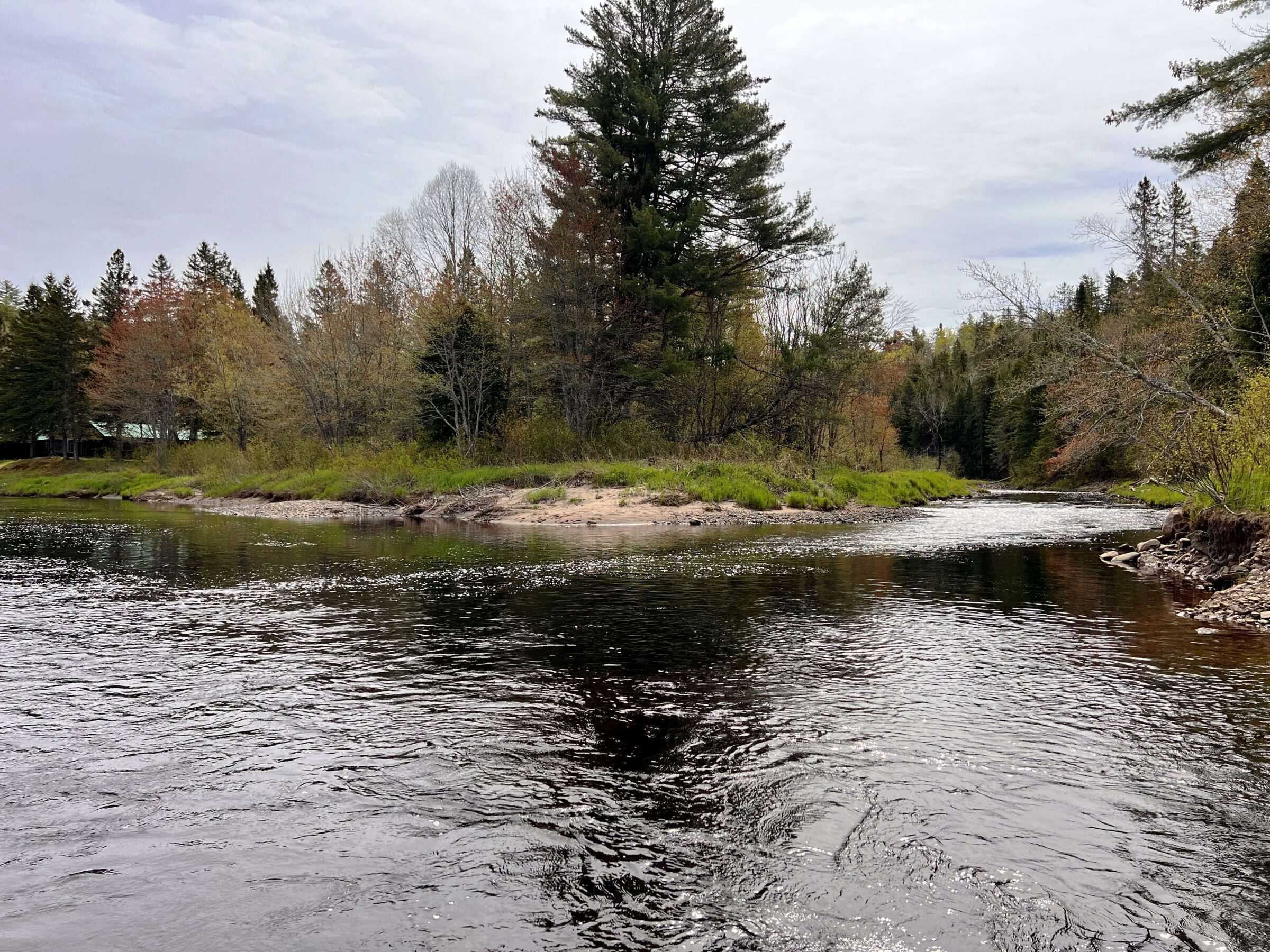
Six Mile Brook with the camp roof visible on the left. Long time BBSC guide Donnie Colford told me he had observed salmon spawning in Six Mile.
The Miramichi is known for its salmon, and rightfully so – after all, it has always had one of the largest populations of Atlantic salmon in North America, and one of the richest sport fishing histories. A lesser-known fact is that while the lower portions of the main stem of the SW and NW branches are modestly populated with humans, the vast majority of the watershed is essentially a wilderness setting. The Cains River, the SW Miramichi’s largest tributary, and a very substantial river in its own right, has some 70 miles of fishable water, and from one end to the other there are no year-round residences.
All branches of the Miramichi are fed by an incredible number of streams and brooks. Something like 40% of the salmon spawning habitat of the Miramichi River is located within these brooks. Brook trout, our very own native char, spawn and live in essentially every one of the tributaries – as well as the main river. The tribs are vital not just for spawning habitat, but in the summer as the main river warms, the brookies – which are less tolerant of warm water than salmon – retreat to the creeks and spring
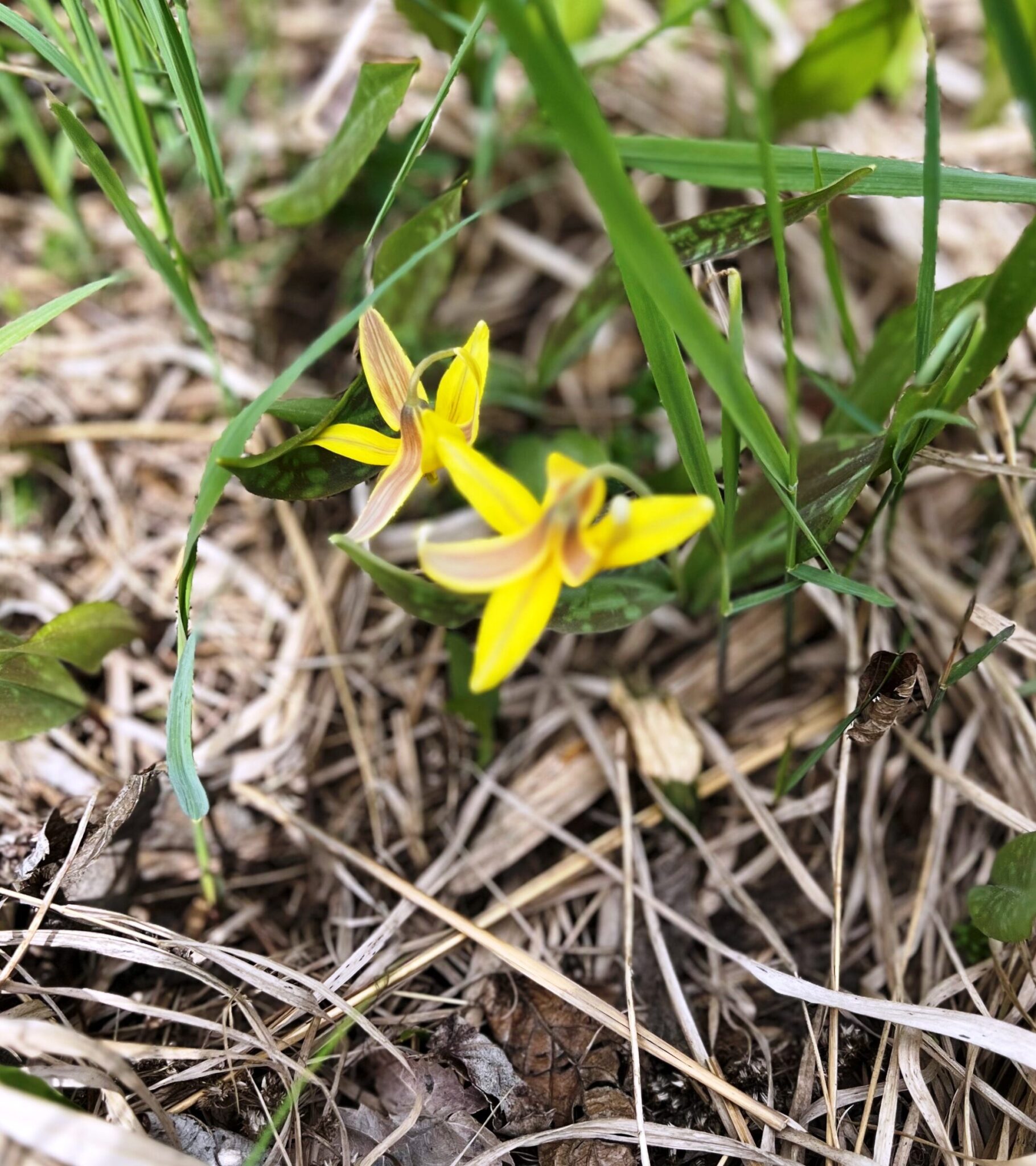
Yellow trout lily wildflowers blooming among last year’s dead grass on the shore of the Cains River.
holes to find the necessary cool water.
Additionally, the relatively warm and gentle nature of the Miramichi make it home to tons of aquatic insects. Trout fishing in the area of Mahoney Brook, twenty miles up the Cains this past week, there were caddis, mayflies and stone flies coming off the water in various intensities off and on all the time I was fishing. Some of the stone flies were literally as large – in length and diameter – as my little finger. With this chow line the Miramichi is truly a haven for salmon parr and wild brook trout. The riverine brookies are not the giants of Labrador fresh waters, but the occasional one does reach a couple of pounds or more, and there are sea run brookies that have been known to weigh upwards of 7 pounds. Since 90% or more of the brookies live further up in the river than regularly ascended by the stripers the great majority of the population is relatively safe.

This brookie took a large, gray Wulff during a hatch of both mayflies and caddis on the Cains River.
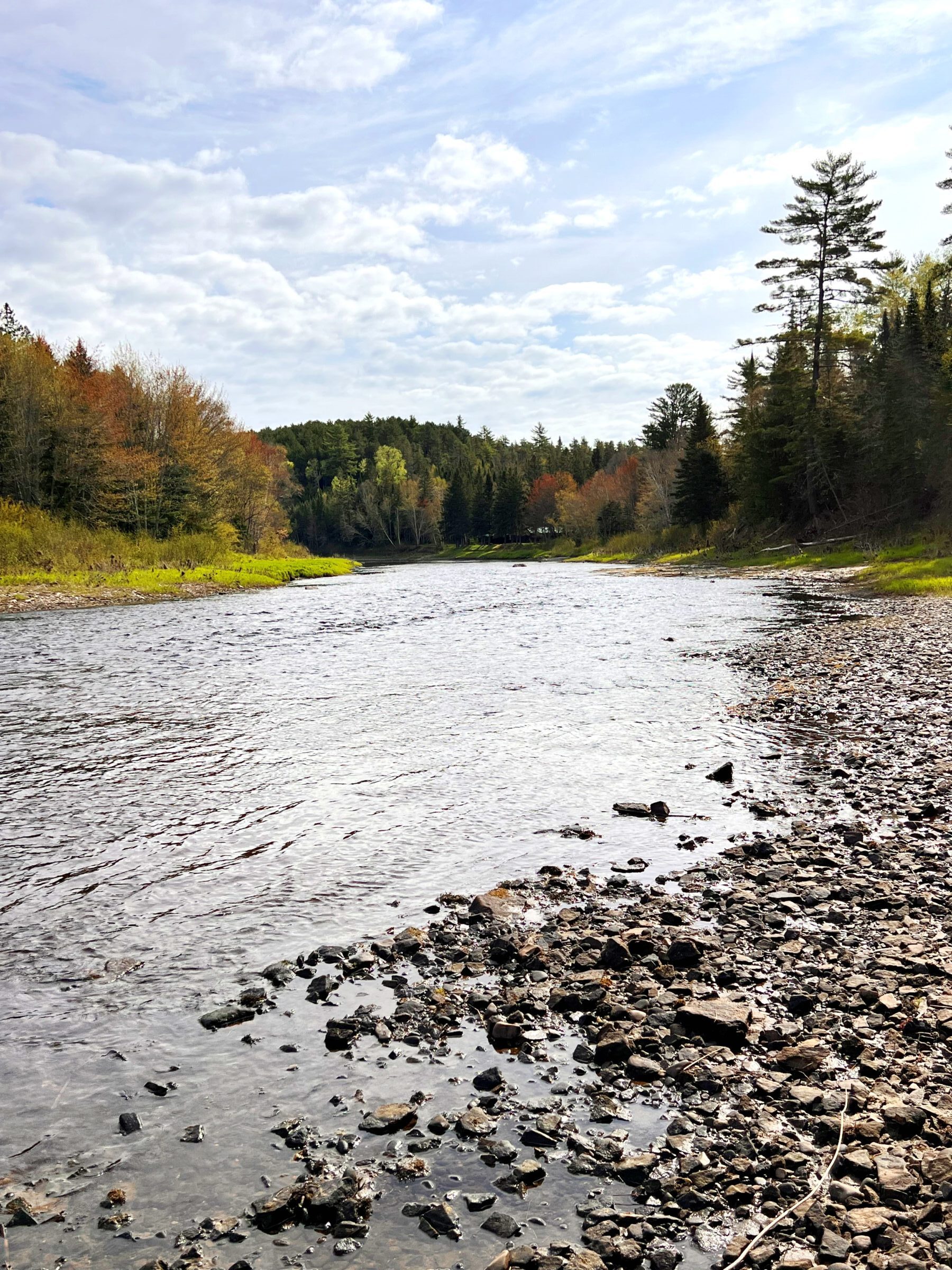
The shallow, fast riffle you can see in the middle is the start of a long run. This riffle was filled with salmon smolts and a few trout. I was forced to move on down into bigger water to get away from the smolts.
The brookies are available as soon as the season opens, and some are caught all through the kelt fishing season. Sea runs, waiting to come back up to the headwaters to spend the summer are caught with some frequency by fishermen down near the head of tide. They have spent the cold weather months feeding in the estuary. After the late spring and early summer insect season, they lay in spring holes and brook mouths near the same areas in the river where they will spawn in the fall. While the larger sea runs are safe from even the biggest stripers, the smaller ones are not, and with the river’s overprotected and out-of-control striped bass population sea run brookie numbers are a shadow of what they were 15 years ago. Still in all the overall brook trout population of the Miramichi is very good. On my recent trip, I fished a little stretch of the Cains from my Mahoney Brook camp downstream to Six Mile Brook, and then another stretch further down in Shinnickburn village. There were brook trout seemingly everywhere: in the fast water riffles, in the deep slow pools and just about everywhere else in between. At one point I was wading in the middle of a pool, standing in shin deep water, and casting to a deeper run along the far bank. I started noticing a few mayflies and caddis coming by me on the breeze. I soon started to see trout rising everywhere including the shallow water I had just walked through. I put on a dry fly and covered a rise in that same shallow water and hooked a beautiful 12-inch brookie. This action continued most of the afternoon.
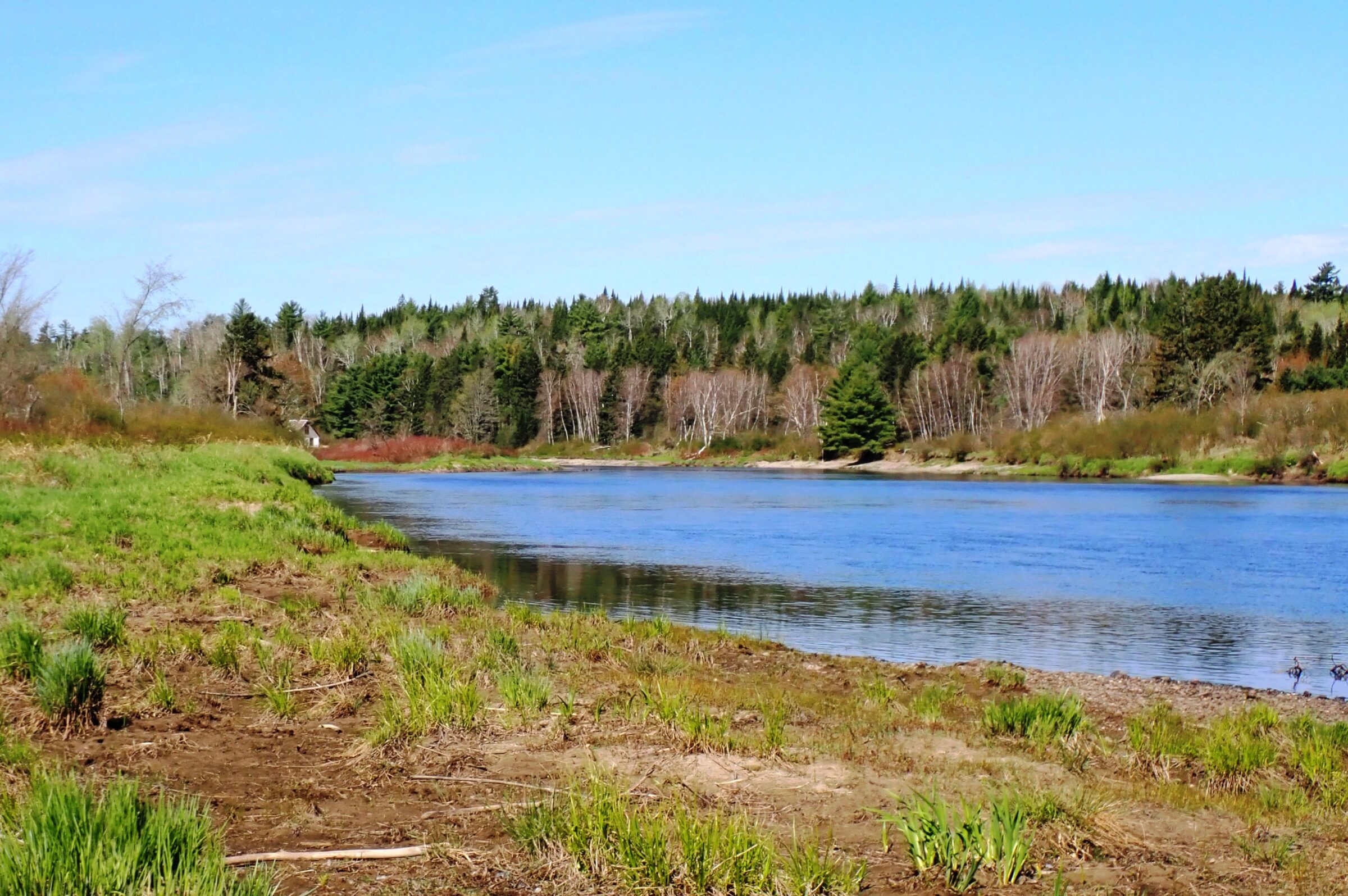
Being on the Cains is like fishing in the pages of a beautifully illustrated fishing book. This photo starts in the pool once owned by John Taylor Armes who together with his wife Dorothy fished with and wrote about their trips with Harry Allen and Charlie Wade. The camp peaking around the upstream corner is now owned by Nick Keenan, but was once part of the Cashen’s Camps so well known in the 50s and 60s for fall salmon action. Just click on any photo to expand it to full size.
I have found that the brookies will take a very wide variety of wet flies. The ghost series with black being my favorite, all work great. More modern flies like wooly buggers and fur strips also catch well as do just about all the traditional bucktail streamers. I’m particularly partial to soft hackle patterns. One of my favorites is a no-name thing I tie with drab olive soft hackle from one end to the other. When I walked into the Cains right in front of my camp early last Thursday morning, I tied one on and wiggled it in the water at my feet to watch the action. A 6-inch brookies came out of hiding beside some nearby rock, and it grabbed the fly which was attached to 2 feet of mono that I was still holding in my hand!
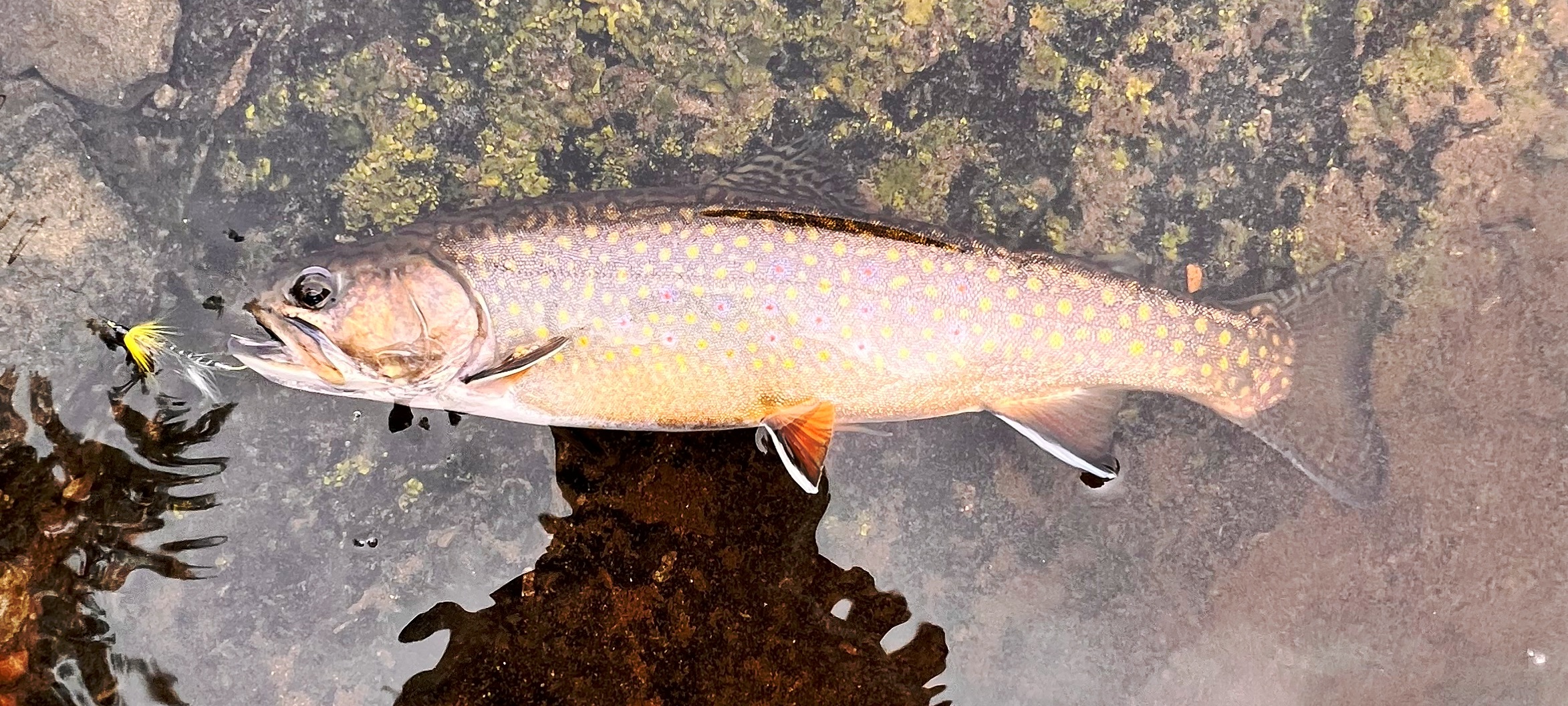
This beautiful brookie is still hooked by the black ghost streamer that he may have mistaken for a fat stone fly tumbling downstream.
Unless it gets too hot, brook trout fishing continues on in the streams and headwaters of the Miramichi and tributaries through the summer. In general, though, the fishery that is going on right now comes to an end by mid-June over most of the river system. It is sure a great way to pass a few days between kelt fishing and the arrival of the first bright fish.
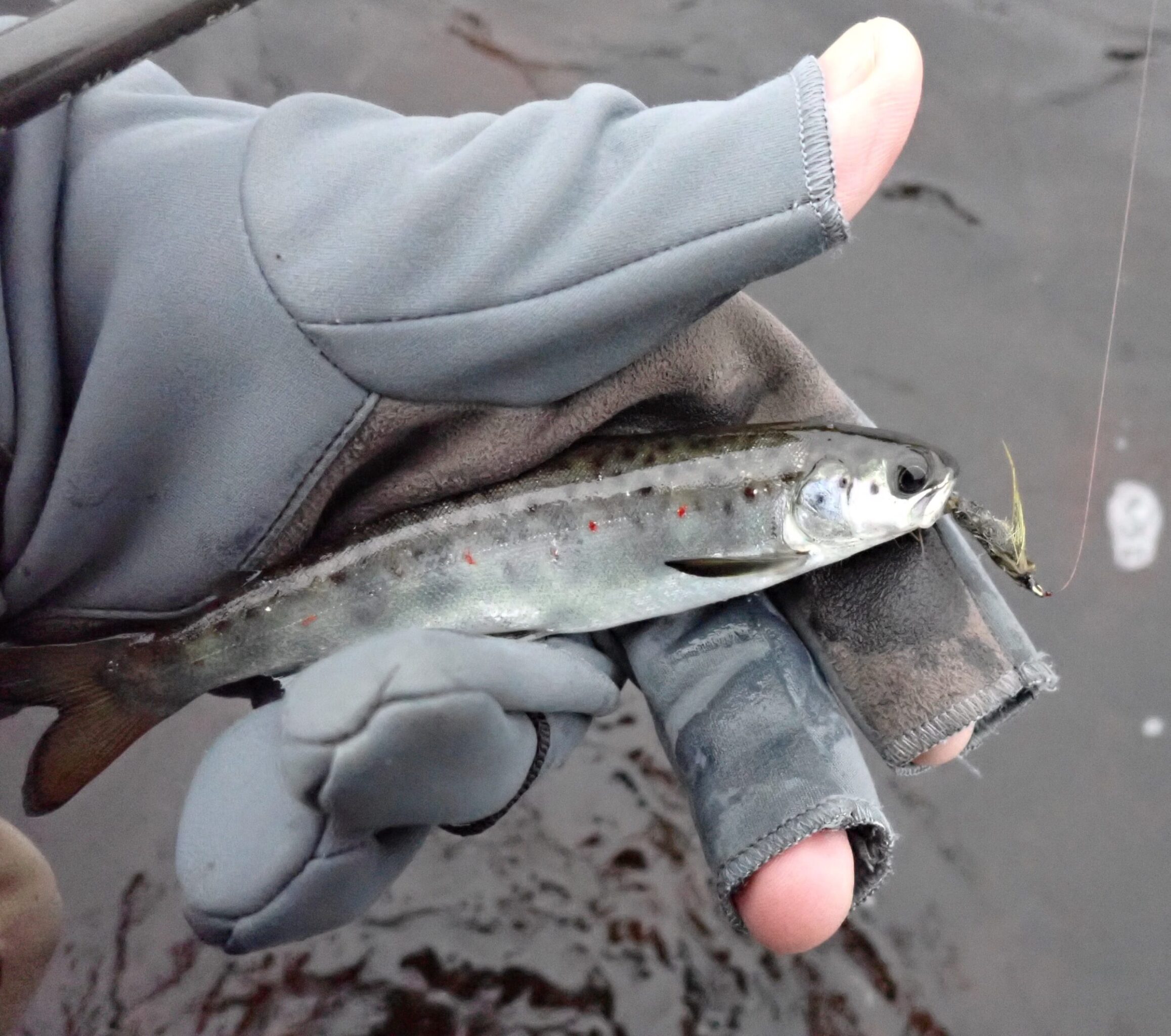
This little guy could be back in two years as a 9-pound hen salmon, or thanks to a callous DFO it could just be one more gulp for one of the striped bass infesting the lower pools of the Miramichi.
This year I again found a good number of salmon smolts mixed in with the trout. The smolts are a little fussier about their water. They want fast water riffles and like them to have a jagged rocky bottom to provide some real cover. At times, as the fly skimmed through the riffles, riding just under the surface, you could feel the tugs of the small salmon and frequently they would flip out of the water in their pursuit of the fly. I time my spring trip to the Cains for this period because I know it coincides with the smolt run. The run begins at the end of the first week in May and some are still going out in the early days of June, but right now is more or less the peak. I’m relieved to see that the river is still producing good numbers of smolts. In my very unscientific experiment, I don’t see much difference over the last 15 years, but I know that the story is very different once they hit that army of bass that now stretches from Black Brook to Quarryville. The NW is even worse, and according to MSA biologists, last year in at least one tributary of that branch the smolt numbers sampled in the rotary traps appeared to be down by close to 75% from historic averages.
So, what is the progress on bringing stripers into some balance with the rest of the Miramichi eco-system? At the recent Plamu conference, and actually on an ongoing basis all winter long, recreational advocates and members of organizations like the MSA and ASF have done their best to convince DFO to act to help the Miramichi salmon. In fact, they have been quite emphatic and even aggressive about it. What we have seen instead are tiny liberalizations of the fishery regulations and major league foot-dragging. Everyone is becoming very fed up with the whole thing. Stay tuned as much stronger measures are in the planning stage.
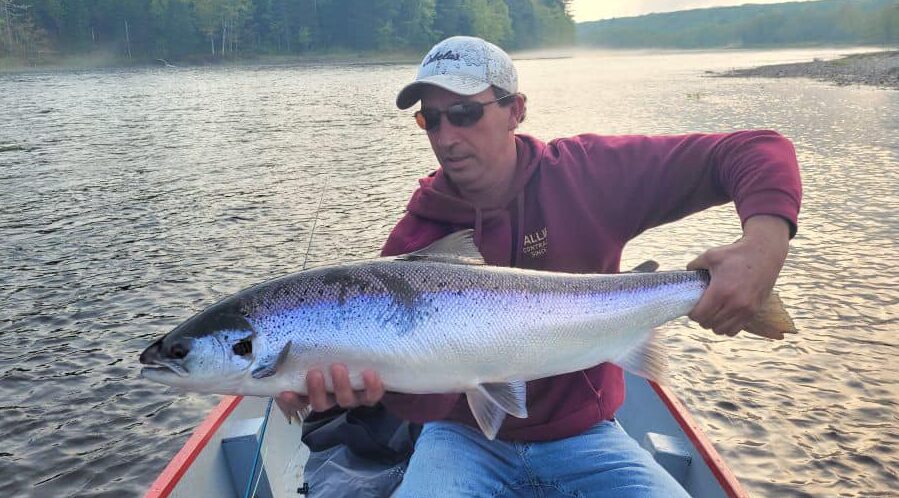
Colin Gilk’s splendid catch from May 2023 – one of two he caught that month – would have won him a $100 gift certificate in 2024.
We are all waiting now for the first bright salmon of 2024. That fish has certainly already entered one branch or another of the system. This year I’m kicking off a new program called First Miramichi Bright Salmon 2024 to celebrate that first, verified silver fish. There aren’t many rules:
- Take a photo with a cell phone or digital camera and attach it to an e-mail to me at bigbass@maine.rr.com. Try and estimate the length, but don’t struggle with this if not convenient. The name of the angler must be included along with the river and town it was caught in. You do not have to say what pool it was caught in.
- You must submit a photo that has you and some part of the fish. Either have a friend take it or take an arms-length selfie. An additional full photo of the entire fish. The photo file must indicate the date that is claimed.
- The winner of First Miramichi Bright Salmon 2024 will receive a $100 gift certificate to their choice of Miramichi area fly shop.
- You give me the right to post the photos and names of all submissions in my blog and/or on social media.
Thanks for reading, and I hope you catch that first bright salmon. Brad Burns
Late breaking good news! The Miramichi Salmon Assoc “MSA” has received permission from DFO to stock the fry from salmon spawned last fall in the MSA hatchery. These fry, numbering over 1M, are the progeny of not only wild parents collected from the MSWM earlier in the fall, but of several hundred adults grown in the hatchery from wild smolts collected on SWM and Dungarvon four years ago. This is an extremely important development since a great deal more of this needs to be done until the bass population can be reduced to compatible levels with the rest of the ecosystem. The call is out for volunteers to help take these tiny fish to the river and release them. If you are interested in participating, please e-mail the MSA hatchery manager Holly Labadie. holly@miramichisalmon.ca


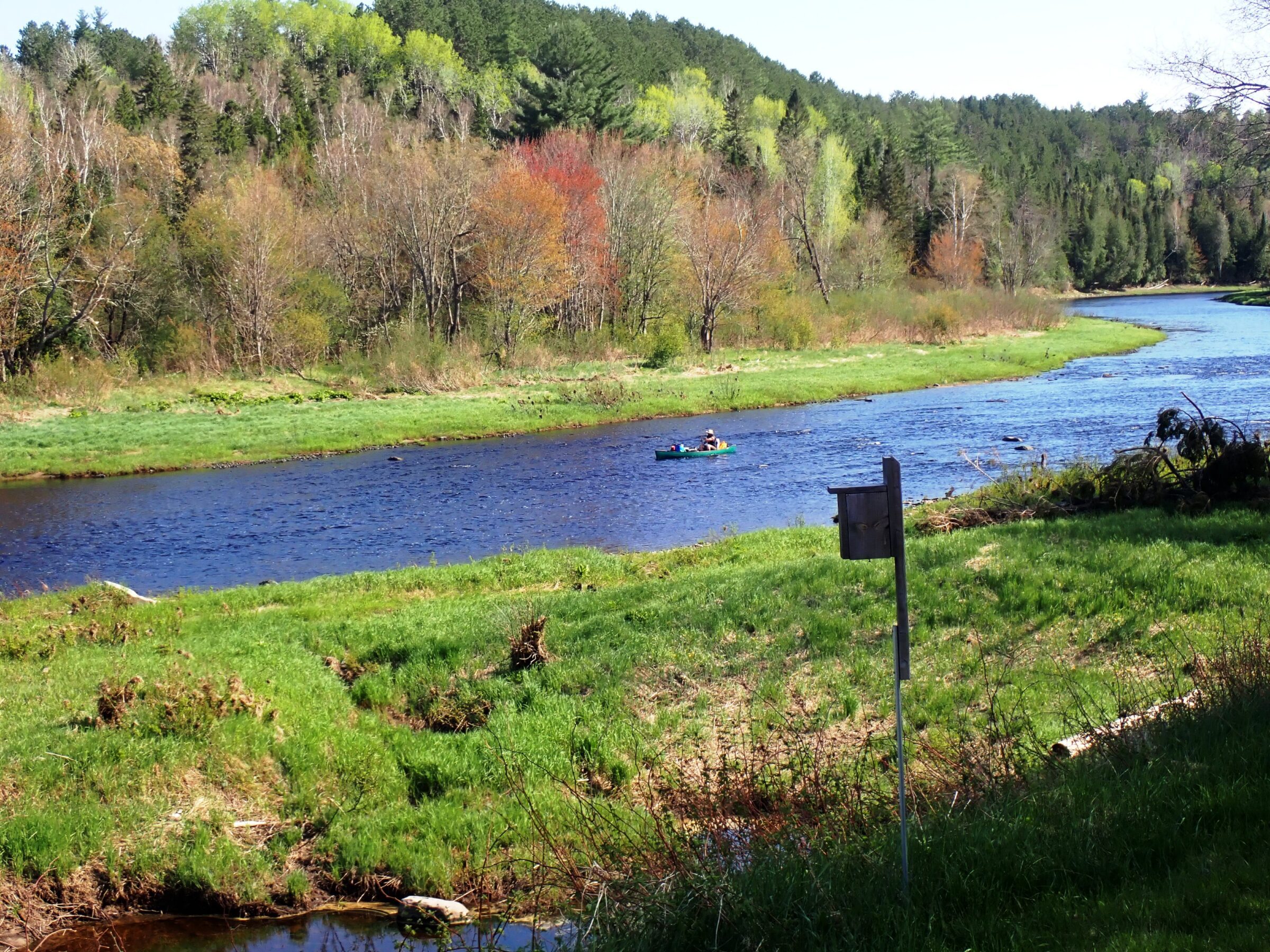
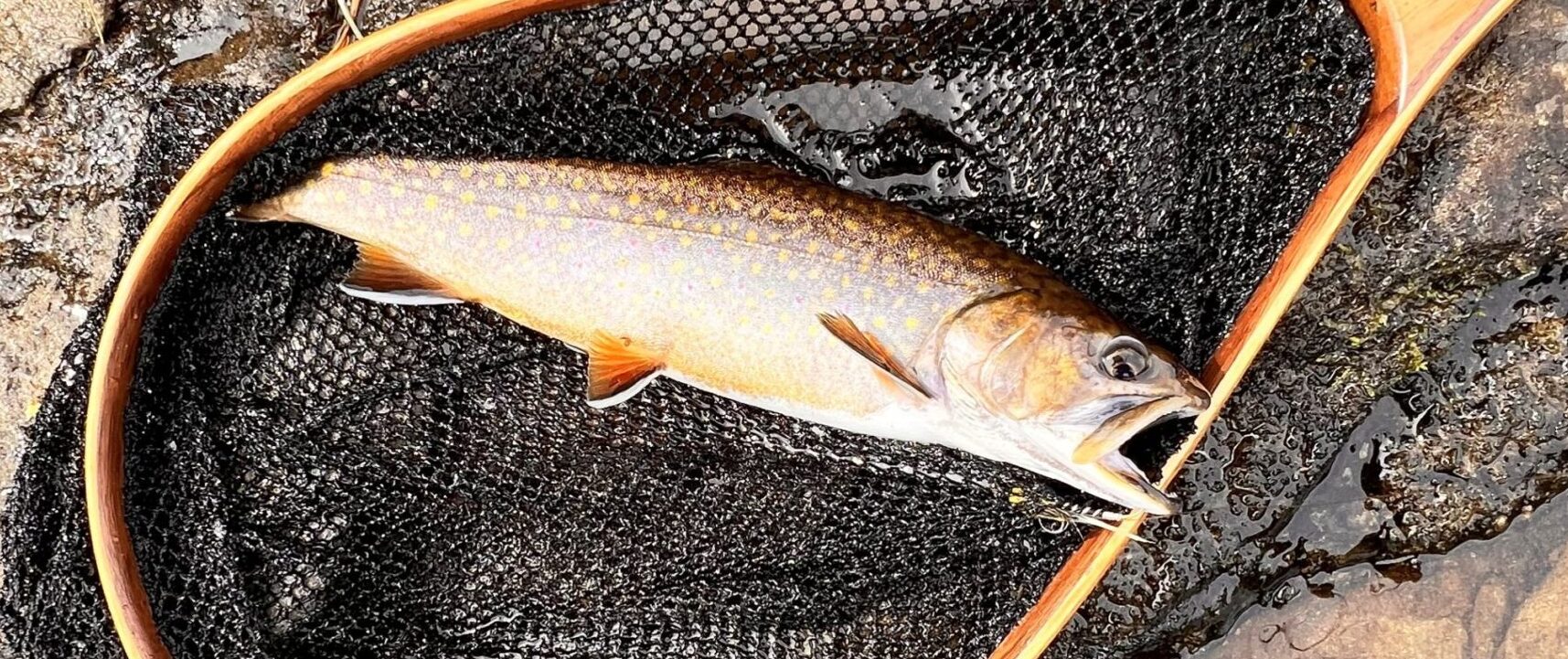
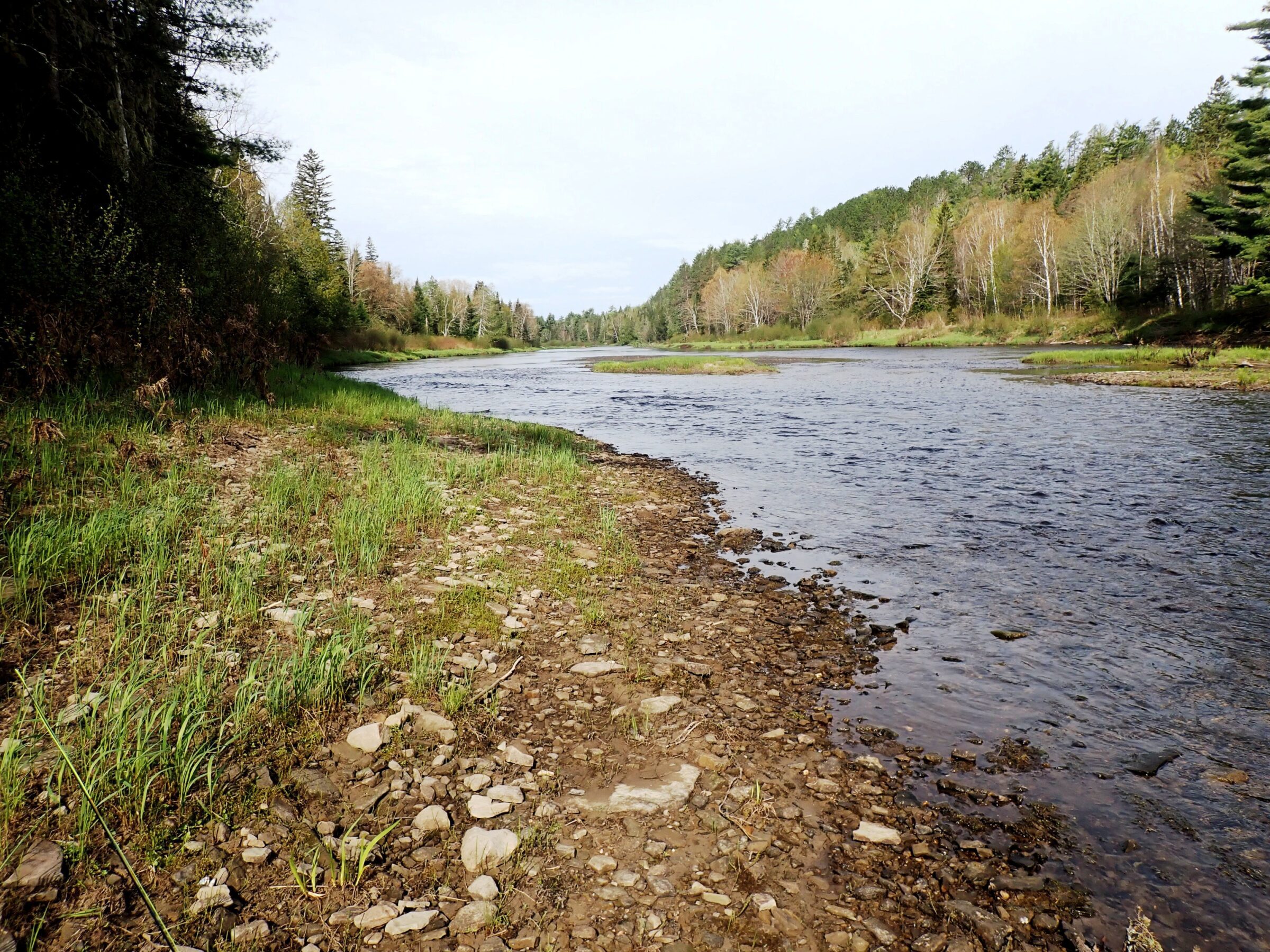
Another great article, I look forward to reading each one, keep them coming Brad!
Thanks Phil. It certainly was a great trip.
Great report!
Thanks Rick. I wish I were up at Campbell’s trying every day for a bright salmon.
One of the major issues with DFO and the striped bass is that the DFO Gulf Region is actually quite proud of what they’ve done with the striped bass and look at the high numbers as a great success story.
Thanks Bob. I suppose that is only natural, but they know that this terrific imbalance is crippling every other fishery in the river. That can’t be allowed to continue.